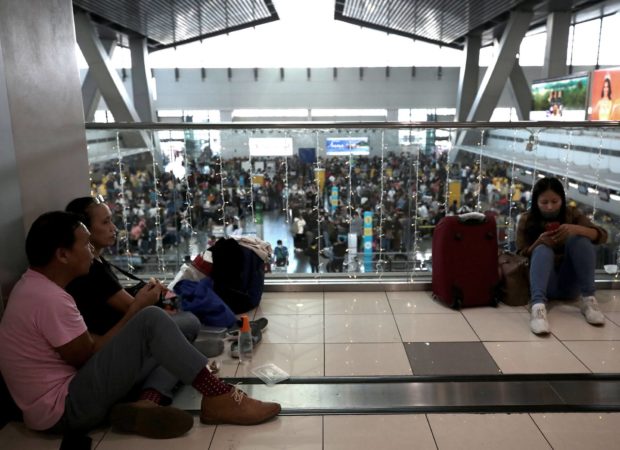Solon claims China may have a hand in Naia power outages

FILE PHOTO: Passengers queue at Ninoy Aquino International Airport Terminal 3 in Pasay City as they wait to board their flights following the resumption of airport operations on Jan. 2, 2023. INQUIRER file photo / RICHARD A. REYES
MANILA, Philippines — A lawmaker has raised the possibility of China’s involvement in the power issues that affected the Ninoy Aquino International Airport (Naia) twice this year, saying that Chinese individuals are managing the National Grid Corporation of the Philippines (NGCP).
During the hearing of the House committee on transportation on the Naia fiasco, Santa Rosa City Rep. Dan Fernandez said several officials at the NGCP are Chinese nationals, claiming that it is a violation of the 1987 Constitution.
Naia encountered two major hiccups in operations in 2023, first in January 1 or New Year’s Day when the entire Philippine airspace was shut down and last May 1 when Naia Terminal 3 was forced to stop operations for hours. Both disruptions were traced to electric current issues.
“We are giving NGCP the power to construct, install, maintain, operate, rehabilitate, along with all of the maintenance and operations of our grid. And who are the owners of the NGCP — 40 percent of the NGCP is owned by the Grid Corporation of China,” Fernandez said in a mix of English and Filipino.
“They audit our transmission line, they audit all the grids in the entire Philippines,” he added.
Article continues after this advertisementHe then claimed that the incidents affecting Naia were done after the country strengthened its ties with the United States (US), citing vice president Kamala Harris’ visit to the Philippines last November 2022 to discuss the possible new Enhanced Defense Cooperation Agreement (Edca) sites, which were eventually announced by Malacañang in April 2023.
Article continues after this advertisementREAD: US VP Kamala Harris to affirm defense commitment to Philippines
“If the Chinese corporation — whose boss is China’s President Xi Jinping — then we can surmise Mr. Chairman, somehow what happened in January 1… prior to that US vice president Kamala Harris visited the Philippines for additional Edca sites (to be) constructed, (she) even went to Palawan, 980 miles away from Taiwan. And after that January 1 happens,” Fernandez said.
“By March 22, the biggest USS Aircraft naval fleet arrived in the Philippines, and was docked at the Manila Bay. This is March 22. And after March 22, what did the Chinese government say? ‘We hope that the Philippine and US government, notwithstanding your relationship, would not affect the relations of the Philippines and China. Then May 1 happened,” he added.
But Fernandez’ fellow lawmakers have raised questions regarding the claim. Sagip party-list Rep. Rodante Marcoleta asked Manila Electric Company (Meralco), which supplies power to Metro Manila and neighboring provinces including Naia, if the scenario mentioned by Fernandez is possible.
Marcoleta expressed doubts about China being able to remotely control the electric flow in the country, even as he agreed with Fernandez that the Grid Corporation of China owns 40 percent of the NGCP consortium.
“The owner of the transmission line is TransCo (National Transmission Corporation), but it is operated by NGCP — Cong. Dan Fernandez is correct, 40 percent of that is owned by China Grid. But because of his theory, there might be a conspiracy. Is it possible because there is an ongoing conspiracy — that this 40 percent, the operation is coming from China, by remote?” he asked.
“Is there a possibility that through remote access — even if it is in the transmissions only, going from generation, transmission lines, towards consumers, and you (Meralco) distribute it, is there a possibility that the Chinese mentioned would just click something and the voltage you are distributing would fluctuate?” Marcoleta added.
Meralco representatives led by company vice president Engr. Sante Buella said that based on their knowledge, a fault current is the cause of the May 5 power disruptions.
“Regarding the possibility, we are actually not too familiar with the setup of NGCP and how they control their operations,” Buella said.
“No, you were saying earlier, if electric wires stick together, we would have a short circuit. But you (Meralco) release electricity, right? NGCP does not have something to do with that? So maybe the problem here is that the cables you used are substandard,” Marcoleta noted.
“Our cables used conform to international standards and also with the Philippine standards,” Buella replied.
Meralco also explained that their diagnosis of the May 1 issue at Naia Terminal 3 always leads to the current transformer (CT).
“When we traced the fault, we saw some tracking. So by tracking we mean that there was a breaking down of the insulation of the CT, there seemed to be some flashes,” Buella said.
“So there is a zero possibility that no matter what the Chinese will do to remote access, they cannot change the voltage supplied to you. There cannot be any possibility?” Marcoleta asked.
“In this particular case we see that (zero possibility),” Buella replied.
Naia Terminal 3’s operations were affected for eight hours after a fault current was discovered, affecting at least 9,391 passengers from 1:05 a.m. to 8:46 a.m. of May 1.
READ: Meralco exec: ‘Fault current’ triggered power outage in Naia Terminal 3
Meanwhile, the New Year’s Day incident forced all Naia Terminals to stop sending out and receiving flights, after its Communications, Navigation and Surveillance Systems for Air Traffic Management (CNS/ATM) failed to function.
Authorities said that a cooling blower of its main uninterruptible power supply (UPS) conked out, forcing the airport to rely on backup power. However, the backup UPS also did not function, prompting technicians to try routing power directly to the CNS/ATM.
However, an overvoltage to the system eventually fried several key satellite components — leaving over 60,000 passengers stranded.
RELATED STORIES:
UPS failure caused glitch at CAAP’s Air Traffic Management Center, says DOTr
READ: Business and gov’t execs, netizens lament New Year air traffic system glitch